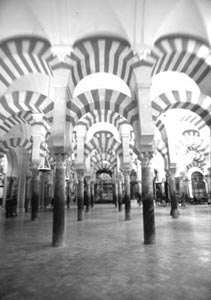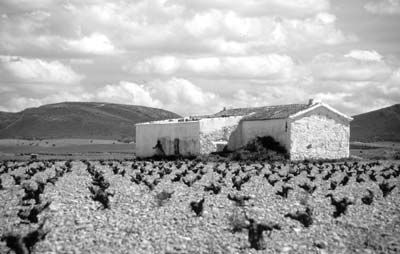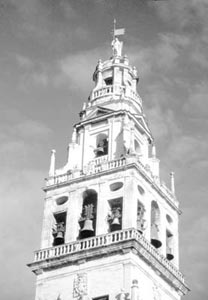Beautiful, historical Córdoba, Spain
by Ed Kinney
First impressions set the tenor of an adventure. The sky may have been overcast that day in April 2004, but I was immediately charmed by Córdoba, Spain, a historic city of three cultures.
Our small van entered by crossing the Rio Guadalquivir via the 2,000-year-old Roman bridge (Puente Romano), built following Caesar’s victory over the Roman general Pompey. A single tower (Torre de la Calahorra) guards the entrance to this bridge, further enhancing the first sighting of the famous Mezquita de Córdoba on the far side of the river, a river once deep enough for boats to navigate between Córdoba and the Atlantic.
Mezquita de Córdoba
After checking into the Lola Hotel in the old Jewish quarter (Juderia), I walked the three short blocks to the Mezquita de Córdoba, now clothed in beautiful early evening light. It being siesta time, streets were nearly empty — ideal for leisurely viewing of the mezquita’s (mosque’s) exterior battered walls, its bricked-up doorways and especially its mix of Arabic and Spanish designs.
In A.D. 711, the first Muslims arrived in Spain from North Africa and quickly defeated the Visigoth monarchy. This marked the beginning of the 700-year Christian War of Reconquest. Shortly after the Muslim victory, emirs representing the Umayyad caliphates in Damascus arrived and assumed leadership of all of Spain (A.D. 601-750). Umayyad rule lasted 250 years until it fragmented into small, warring kingdoms.
In A.D. 785, the Umayyads began construction of this mosque over the Visigoth church of St. Vincent, which in turn had been built over a Roman temple. For the next 200 years, Islamic rulers enlarged Mezquita de Córdoba to become the, then, largest mosque in Islam. The Umayyad era was probably the greatest period of Islamic architecture, both in Spain and throughout the Muslim world.
In 1492, the Catholic monarchy’s army finally defeated the last of the Muslims in Spain and drove them back into North Africa. In 1523, King Charles V directed, sight unseen, that a cathedral be built in Córdoba on the site of the Umayyad mosque, surpassing it in height but not harming its Islamic architecture or design. Later, when seeing the cathedral for the first time, he is quoted to have said, “If I known what you were up to, you would not have done it.”
Mezquita de Córdoba is a hybrid, a marriage of baroque and Umayyad architecture. The Christian part, built in the shape of a Latin cross in the center of the mosque, has a huge dome with religious icons highlighting a red marble altar and baroque pews.
On my visit in April ’04, for nearly an hour I sat quietly in one of the pews, allowing my eyes to wander while listening to the muted voices of guides discussing King Charles V’s cathedral. Breaking reverie, I then wandered slowly throughout the 23,400-square-meter mosque prayer hall with its maze of 500 columns and sectional colored red-and-white superimposed arches.
My destination was the mosque’s qibla wall with its hollowed-out section (mirhab) which faces Mecca, the birthplace of Muhammad. Here, again, voices in many languages were describing this wall’s Islamic significance. My 3-hour visit of Mezquita de Córdoba ended all too soon.
It’s easy to forget that Córdoba has other great sights. I enjoyed wandering the streets, watching families ride in horse-drawn carriages through hospital-clean streets in the Juderia and admiring the Calleja de Las Flores (Street of Flowers). This alleyway, though small, has numerous window boxes, each carefully bedecked with brightly colored flowers.
Later, I viewed the last synagogue (14th century) in southern Spain, near the Gate of Almodovar, and also the Alcazar of Christian Kings with its beautiful gardens. But mostly during these walks, I simply enjoyed observing Córdoba’s Andalusian culture, drawn from its Roman and Arab past.
Parting thought
With today’s confrontations between religions, it’s ironic that Mezquita de Córdoba has shrines for both Christianity and Islam under a single roof in the old Jewish quarter of Córdoba.
Minutiae
• The Lola Hotel (Romero 3, Juderia, Córdoba 14003 Spain; phone 957/2000305, fax 957/422063) has only eight rooms, each with a small modern bathroom and tastefully decorated with Art Deco pieces. The Internet lists the average room price as €140 (near $168); mine, a single, cost €100 including breakfast and VAT. Those with disabilities should request the hotel’s one room on the ground floor.
• My trip to Spain in April ’04 was made with Don Lyon’s Close-Up Expeditions (858 56th St., Oakland, CA 94608; phone 800/457-9553 or visit www.cuephoto.com). It was a photography tour and I received a partial discount.
• At the time of my visit, entry to the Mezquita de Córdoba cost €6.5 ($8). Photography was permitted but no tripods. To steady my camera, I used a “string-pod” or braced it against a pillar, etc., while photographing with 400 ASA slide film.
• For a wonderfully visual online tour of Córdoba, visit www.virtourist.com/europe/Cordoba/index.html.
• Córdoba was dedicated as a UNESCO World Heritage Site in 1984.




